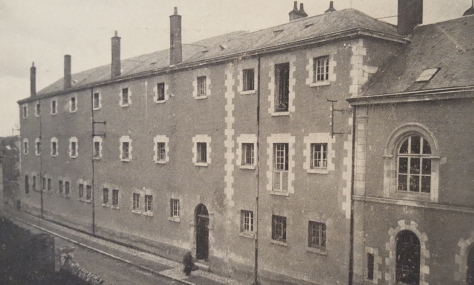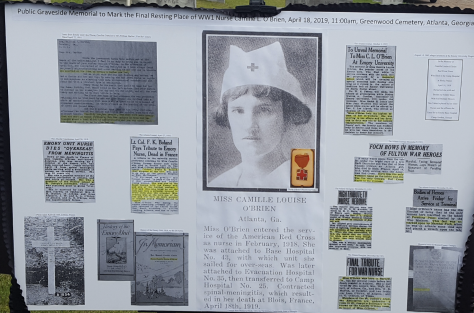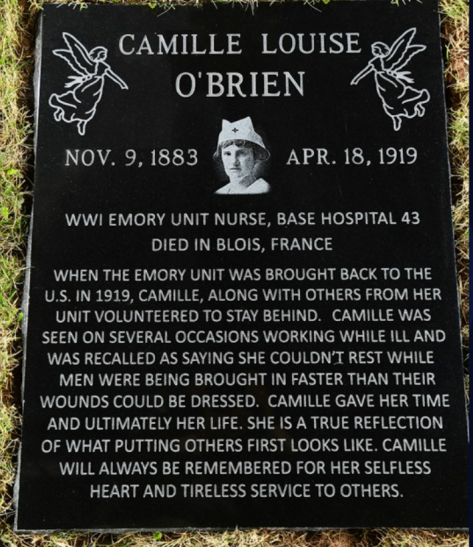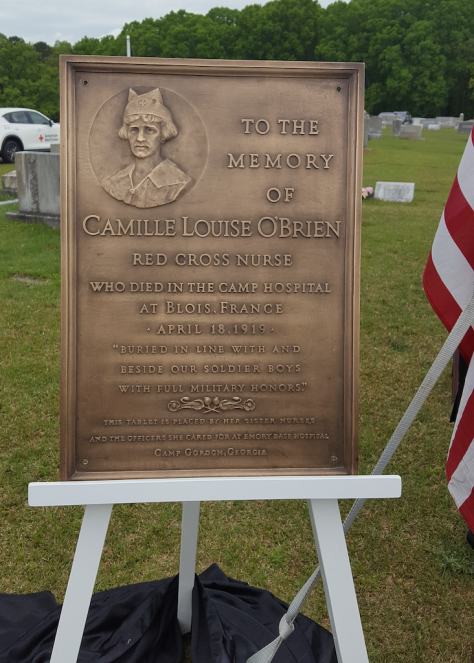In a fifteenth-century building in a quaint French town along the Loire River, about a hundred miles south of Paris, a young American woman gave up her life a century ago for the sake of men who had risked their own lives in the “war to end wars.” Her name was Camille Louise O’Brien, and for nearly a hundred years — until this month — she had lain in an unmarked grave in southwest Atlanta.
The granddaughter of an Irish immigrant, Camille O’Brien grew up near Madison, Georgia, but moved with her father and twelve siblings to Atlanta after her mother’s death. In time, she enrolled in a nurses training program at Crawford Long Hospital (now Emory Hospital Midtown), and then completed her training at St. Joseph’s Infirmary (now St. Joseph’s Hospital, part of the Emory Healthcare system).
When the United States entered World War I, Emory physicians and nurses responded to the call for volunteers to establish a base hospital. Inducted in early 1918 and trained at Fort Gordon, outside Atlanta, the unit arrived in Blois, France, in July and set up Base Hospital 43. There, until the end of January, the physicians and nurses treated every kind of wound, injury, and disease among the soldiers who came to their makeshift wards—more than nine thousand cases in seven months. Nurse O’Brien, admonished for overworking to the point of making herself ill, remarked, “I cannot rest while men are being brought in faster than their wounds can be dressed.”

At the end of January 1919, with the armistice three months old and demobilization underway, the Emory Unit decamped for home but left behind a few volunteers to tend to the soldiers who were still recovering. Nurse O’Brien was one of those volunteers. Two months later, as the worldwide influenza epidemic of 1918-1919 swept through Blois for a second time, she became ill. Back in Georgia her former comrades were saying their goodbyes to each other at Camp Gordon and heading home to their families and friends. In Blois, Nurse O’Brien’s health continued to deteriorate, and on April 18, 1919, she died of spinal meningitis.
She was laid to rest in Blois with full military honors, in line with soldiers who had succumbed to their wounds.

Two years later, her body was exhumed and sent back home, where it once again was laid to rest, this time in historic Greenwood Cemetery. The VFW, the Red Cross, and other organizations paid tribute to the hero nurse. But no one thought to mark the grave. Or perhaps the family could not afford a stone. In any case, while the location was noted in cemetery records, there Nurse O’Brien lay, with only a patch of earth above her, until the hundredth anniversary of her death.
Members of the Georgia World War I Centennial Commission became interested in Nurse O’Brien’s story and determined to mark her grave at last. Along the way, they learned that a memorial plaque had been created and installed at the Emory University Hospital in September 1919. Last May I received a series of emails asking me if I knew of this plaque. Indeed I did not, but along with archivists, Campus Services staff, and many others I began to search. Months went by with no luck.
Then, amazingly, my colleague Sally Wolff King, the official historian of the Woodruff Health Sciences Center, happened to be walking past a bank of elevators on the basement floor of the hospital and looked up to see — the plaque to Camille O’Brien. Sally told me about the location, and I passed along the word to the commission, and before long the plaque had been removed, refurbished, and made ready for a display that will help to perpetuate the memory of this hero nurse.
On April 18, 2019, representatives of Emory, the Red Cross, the VFW, the Georgia World War I Centennial Commission, Georgia Humanities, and Camille O’Brien’s family gathered to remember her and to mark her grave at last. The quiet, windswept hilltop with a view of the Atlanta skyline in the distance suggested that peace at last had come to Camille O’Brien.
For more information about the Emory Unit, see History of the Emory Unit, Base Hospital 43, U.S. Army American Expeditionary Forces, available at the Stuart A. Rose Manuscript, Archives and Rare Book Library, Emory University.
Gary Hauk




Greenwood is in our neighborhood. May have to swing in and look for the marker.
Martin
On Fri, Apr 19, 2019 at 3:49 PM Emory Historian’s Blog wrote:
> emoryhistorian posted: “In a fifteenth-century building in a quaint French > town along the Loire River, about a hundred miles south of Paris, a young > American woman gave up her life a century ago for the sake of men who had > risked their own lives in the “war to end wars.” Her nam” >
LikeLike
A digitized version of the original Emory Base Hospital history is available online. https://archive.org/details/14230690R.nlm.nih.gov/page/n6
LikeLike
Many thanks for noting the availability of this complete history online.
LikeLike